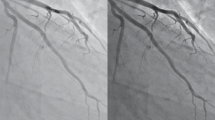Summary
In intact anesthetized dogs left coronary artery blood flow determined by the 133 xenon wash-out technique was compared with coronary sinus outflow measured by a transvenously introduced cannulating electromagnetic flowprobe. 133 xenon was injected selectively into the left coronary artery and its myocardial wash-out detected by a precordial scintilltion counter. Coronary flow was determined over a wide range while increases of flow were produced by the administration of different drugs such as catecholamines, alpha-stimulators, coronary vasodilators and by volume loading.
Below a coronary sinus outflow of less than 100 ml/min, coronary flow estimated by the 133 xenon technique and corrected for the amount of perfused muscle mass was similar to the electromagnetically measured coronary sinus outflow. At a coronary sinus outflow above 100 ml/min, however, a progressive underestimation of 133 xenon flow was observed regardless whether flow was increased by primary coronary vasodilation or essentially by an increase of myocardial oxygen consumption with coronary venous oxygen saturations between 20 and 40%.
Thus, the application of the 133 xenon method for quantitation of coronary blood flow appears to be limited to low flow rates, whereas under conditions of increased flow the 133 xenon technique provides at best semiquantitative measurements of coronary blood flow.
Similar content being viewed by others
References
Andersen, H., Bagger, H., Gotzsche, H.: Non-uniform blood flow in the left ventricular wall of dogs measured by the xe-133-washout technique. Acta physiol. scand.76, 376 (1969)
Baltaxe, H. A., Formanek, G., Loken, M., Amplatz, K.: Clinical limitations to use of xenon for measurement of myocardial blood flow. Invest. Radiol.4, 317 (1969)
Bassingthwaighte, J. B., Strandell, T., Donald, D. E.: Estimation of blood flow by washout of diffusible indicators. Circulat. Res.23, 259 (1968)
Brandi, B., Fam, W. M., McGregor, M.: Measurement of coronary flow in local areas of myocardium using xenon 133. J. Appl. Physiol.24, 446 (1968)
Cherrier, F., Robert, J., Cuillière, M., Mabille, H.: Mesure du débit coronaire à l'aide du xénon 133 au cours des coronarographies sélectives, étude préliminaire. Arch. Mal. Cœur65, 1473 (1972)
Conn, R. L.: Equilibrium distribution of radioxenon in tissue: Xenon-hemoglobin association curve. J. Appl. Physiol.16, 1065 (1961)
Donato, L., Bartolomei, G., Federighi, G., Torreggiani, G.: Measurement of coronary blood flow by external counting with radioactive rubidium. Circulation33, 708 (1966)
Doutheil, U., Rhode, R.: Messung der Koronardurchblutung mit der Auswaschtechnik radioaktiver inerter Gase (133Xe,85Kr) im Zusammenhang mit der Frage der Durchblutungsverteilung im Myokard. Verh. dtsch. Ges. Kreisl.-Forsch.32, 273 (1966)
Gregg, D. E., Fisher, L. C.: Blood supply to the heart: In: Handbook of Physiology, Section 2: Circulation. Vol. II, p. 1517. Washington 1963
Holmberg, S., Luepker, R., Varnauskas, E.: Influence of recirculation on myocardial clearance curves with xenon 133. Acta med. scand.189, 241 (1971)
Holmberg, S., Paulin, S., Prerovsky, I., Varnauskas, E.: Coronary blood flow in man and its relation to the arteriogram. Amer. J. Cardiol.19, 486 (1967)
Holmberg, S., Serzysko, W., Varnauskas, F.: Coronary circulation during heavy exercise in control subjects and patients with coronary heart disease. Acta med. scand.190, 465 (1971)
James, T. N.: Anatomy of the coronary arteries in health and disease. Circulation32, 1020 (1965)
Kober, G., Kaltenbach, M., Bonath, K., Hacker, H.: Regionale Myokarddurch-blutung im normalen und chronisch druckbelasteten linken Ventrikel. Tierexperimentelle Untersuchungen mit der 133 Xenon-Clearance. Z. Kreisl.-Forsch.60, 471 (1971)
Klocke, F. J., Koberstein, R. C., Pittman, D. E., Bunnell, I. L., Greene, D. G., Rosing, D. R.: Effects of heterogeneous myocardial perfusion on coronary venous H2 desaturation curves and calculations of coronary flow. J. Clin. Invest.47, 2711 (1968)
Klocke, F. J., Rosing, D. R., Pittman, D. E.: Inert gas measurements of coronary blood flow. Amer. J. Cardiol.23, 548 (1969)
Lochner, W.: Physiologie der Koronardurchblutung als Grundlage für die Beurteilung von Coronardilatatoren. Naunyn-Schmiedebergs Arch. Pharmak. exp. Path.263, 127 (1969)
Rau, G.: Messung der Koronardurchblutung mit der Argon-Fremdgasmethode. Arch. Kreisl-Forsch.58, 322 (1969)
Redding, V. J., Rees, J. R.: Experimental myocardial infarction: a comparison of myocardial flow rates in the vicinity of the infarct with that in much distant muscle. Brit. Heart J.31, 392 (1969)
Ross, R. S., Friesinger, G. C.: Anatomic and physiologic considerations in measurements of myocardial blood flow. Circulation32, 630 (1965)
Ross, R. S., Ueda, K., Lichtlen, P. R., Rees, J. R.: Measurement of myocardial blood flow in animals and man by selective injection of radioactive inert gas into the coronary arteries. Circulat. Res.15, 28 (1964)
Author information
Authors and Affiliations
Additional information
This work was supported by a grant of the Swiss National Science Foundation.
Rights and permissions
About this article
Cite this article
Hirzel, H.O., Krayenbuehl, H.P. Validity of the 133 xenon method for measuring coronary blood flow. Pflugers Arch. 349, 159–169 (1974). https://doi.org/10.1007/BF00586626
Received:
Issue Date:
DOI: https://doi.org/10.1007/BF00586626



